Imelda Connolly: Embracing creative confidence

For the last twenty years, Imelda Connolly harboured a secret dream. The dream of becoming an artist. But with no formal training, she fuelled her passion by creating small textile collages in private, never finding the courage to share what she made.
She would while away hours in fabric shops seeking out unusual textured and patterned fabrics.
But she became increasingly frustrated by the limitations of relying purely on the materials themselves to create interest and lacked confidence in her own abilities; she longed to have the skill to make her own designs with stitch.
With no access to suitable in-person courses in her area, Imelda began to search for guidance online.But the courses she found were expensive and required lengthy commitments.
When Imelda discovered TextileArtist.org and Sue Stone’s online course Exploring Texture & Pattern she jumped at the chance to register; it felt like a chance to discover new and exciting ways of using embroidery to enhance the visual complexity of the work she was making. And the balance of structure and flexibility (being able to do the creative challenges in her own time) felt less pressured than taking a more formal course.
‘As I moved through the assignments, started posting my work online, and interacted with other students, I became more confident in my ability to use basic stitches in a unique way and started to enjoy showing my work to others.’
Imelda tells us that her life changed ‘dramatically’ after completing the course. As a result of the positive feedback and encouragement she received from Sue and the other students, she joined the Cork Textile Network (CTN).
She immediately had two pieces accepted for the Knitting & Stitching Show and submitted two others to a CTN exhibition named Passing Through, one of which (Mountain View) won the Long Note Award.
In this interview, Imelda tells us more about finding courage in her creativity through being part of a community of textile enthusiasts and how couching, layering and mixing threads in the needle have become integral to her work.
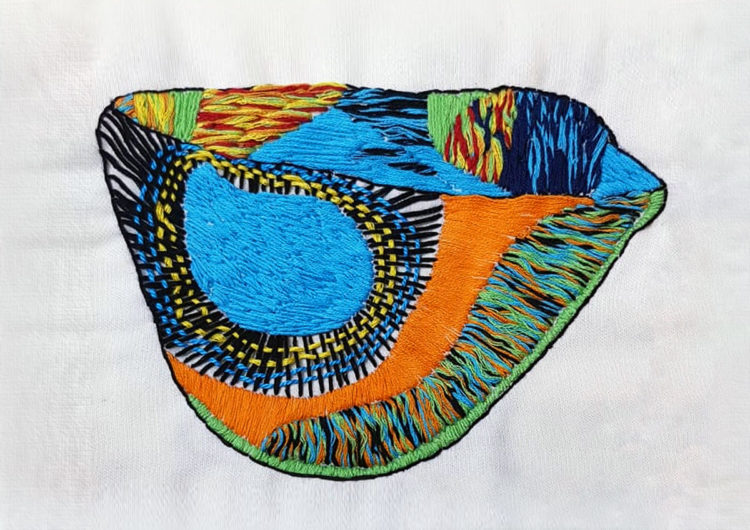
Discovering infinite possibilities with simple stitches
TextileArtist.org: Tell us a bit about your history with art and hand stitch.
Imelda Connolly: My mother Teresa worked from home as a tailor and dressmaker. And so from an early age, I was surrounded by fabrics and threads and the frequent sound of her working away on her Singer sewing machine.
In addition, my parents were close friends with the artist John Skelton and we went to all his exhibitions and often visited his studio to see his latest works.
My sister Patricia McKenna was always very interested in art and she went to the NCAD art college to study Fine Art and became an art lecturer and an installation, multi-media artist. Over the years she has exhibited widely in Ireland, the United States and throughout Europe and recently her work was included in the Collateral Personal Structures exhibition in the Venice Biennale 2017. I’ve attended many of Patricia’s exhibitions and as a result, I’ve come in contact with a wide range of modern art, sculpture and multi-media work.
However, I ended up following a variety of interests which sent me in many different directions from my early textile and art influences.
I became a First Aid instructor, teacher and education lecturer, a computer-mediated communication researcher, ethnomusicologist, a traditional Irish music researcher, and an environmentalist carrying out research with my husband Michael into sustainable fish farming, water pollution reduction and energy conservation.
I also travelled and moved house with Michael and we lived in Canada, Missouri and many different parts of Ireland.
Throughout my adult life, I have always enjoyed crafts based hobbies. At different times I tried out crochet, knitting, weaving, patchwork, batik and felting and I attended some evening classes in pottery and embroidery. Initially, I followed kits and instructions for embroidery, patchwork, knitting and so on and did not design anything myself.
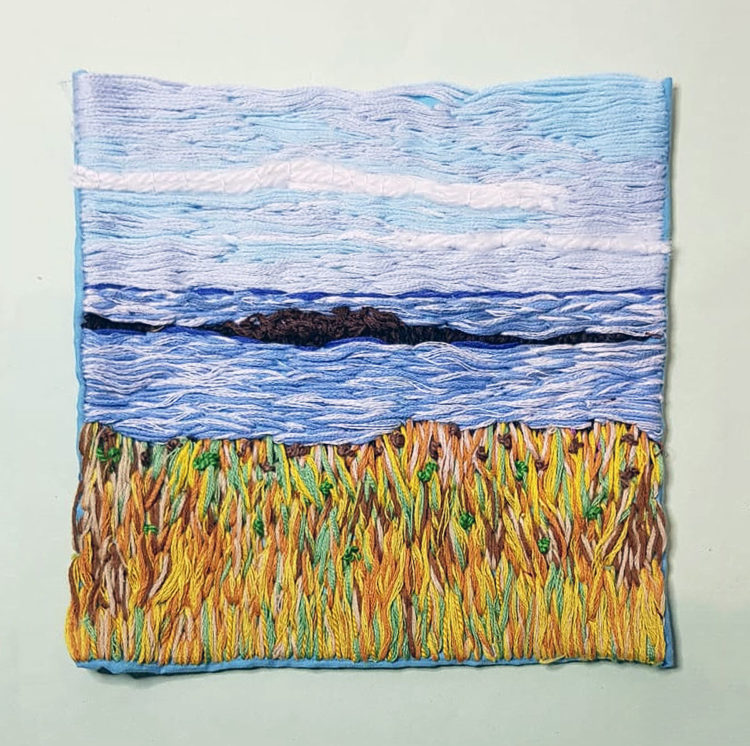
Tell us a bit about your personal journey.
As the years passed by I began to focus more on textiles than on other crafts. I tentatively began to make fabric collages using my own designs. At this stage, I relied on the fabrics themselves to provide textures and patterns.
I really wanted to do some kind of course which would help me understand design principles and how to develop my textile skills. I would have loved to have been able to actually attend textile design classes somewhere but my home is in rural Ireland, a long distance from any art colleges.
When I looked at online courses I found that they were not suitable for me since they were either too expensive or involved long course commitments or examinations. I wanted to learn in a less pressured way.
When I read about Sue Stone’s Exploring Texture & Pattern course I was very excited as it was exactly what I was looking for. The course seemed to be very well organised but still allowed flexibility so that students could work at their own speed through the assignments.
I loved Sue Stone’s work and could see that she was using stitches in a very creative way to create textural designs. I was one of the first students to enrol in the original outing of the course in June 2017.
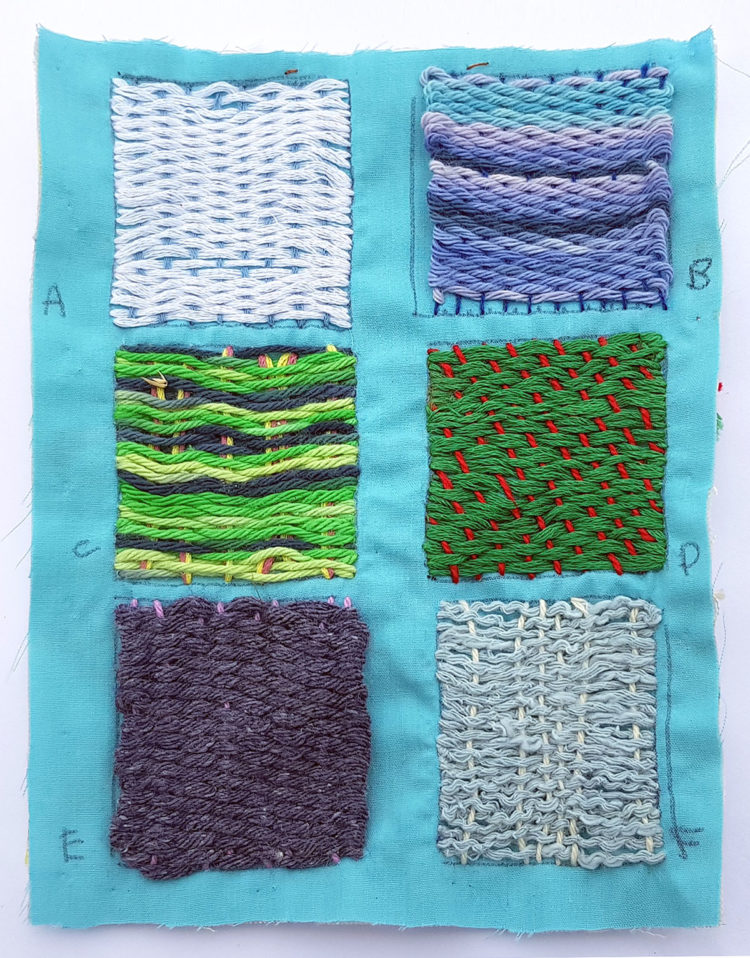
What were your key takeaways from Exploring Texture & Pattern in terms of process?
A key takeaway for me has been to practice and experiment with stitches first, break down any challenge into smaller elements and take it slowly step by step.
Because each assignment was small with grids of only 5cm x 5cm, it was not a very daunting task and so it was easy to just try one little area and then the next and so on. This process encouraged me to stay calm and not to be frazzled by the work.
Experimenting with running stitch in the first module helped me see that by varying the threads, spacing and direction of stitches, very interesting effects could be achieved.
By the time we were introduced to the whole range of simple stitches – running stitch, backstitch, mock herringbone and couching and we could experiment with layering, mixing threads in the needle and weaving, an endless range of possibilities lay before us.
I could see that I did not have to continue to search for particular pieces of fabric to make my designs since I could make the patterns and textures myself, which was a big step forward.
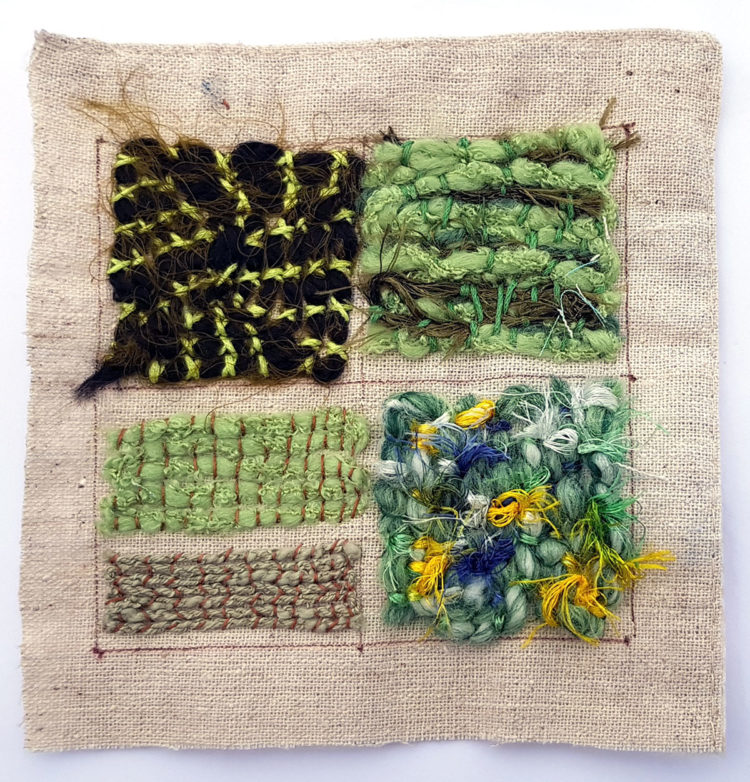
Embracing creative confidence
What elements of making textile art were you struggling with in terms of the creative process and how has your approach changed?
Before I did the course I was very unsure of my creative potential, my textile skills and design abilities. I had very little confidence in myself as a ‘maker’.
However, my experience of doing the stitch experiments and getting positive feedback from Sue and the other students helped build up my confidence. I gained a lot of ‘inside’ information on design, presenting work, exhibitions and solutions to many technical problems from Sue during the webinars; she was always available to give advice and help when needed.
When the course ended I felt confident enough to join the Cork Textile Network (CTN), a group here in Ireland, and within a few weeks of joining I was invited to submit work to an exhibition.
Two small pieces were accepted into the exhibition and I was so thrilled and excited. I know that before I started the course I would never have dreamed of submitting work to an exhibition.
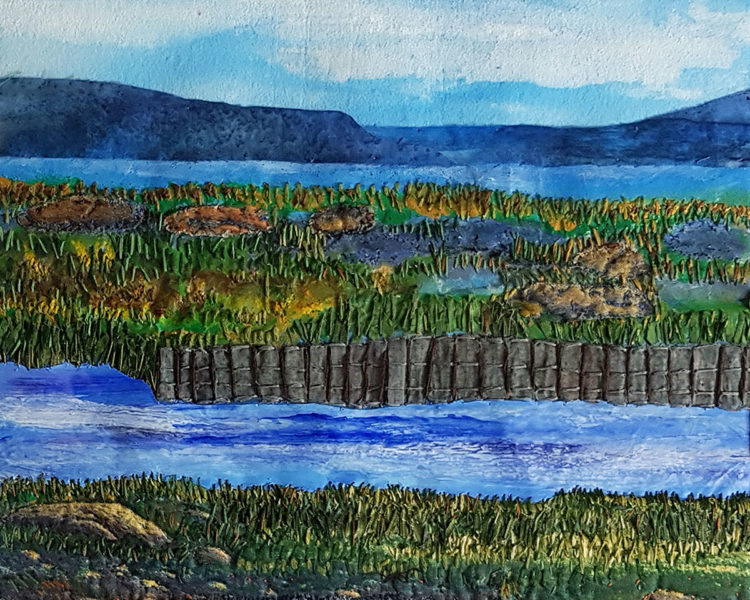
Working within limitations in order to fuel the creative process is a core concept of the course. How did you find that limitations affected the way you worked?
The limited nature of the assignments (for example, using the grid system, spacing, mixing threads in the needle and layering) removed any worries I had that I was not ‘artistic’ or ‘creative’ enough since I was looking at one simple stitch and how many ways I could vary it.
The assignments were achievable enough to change the focus from my own abilities to solving a small puzzle and using simple stitches to complete interesting patterns and textures.
It was great to see the novel way in which other students solved these puzzles when they posted their work and I think this encouraged all of us to be braver and try out different ideas without worrying too much about their success or failure.
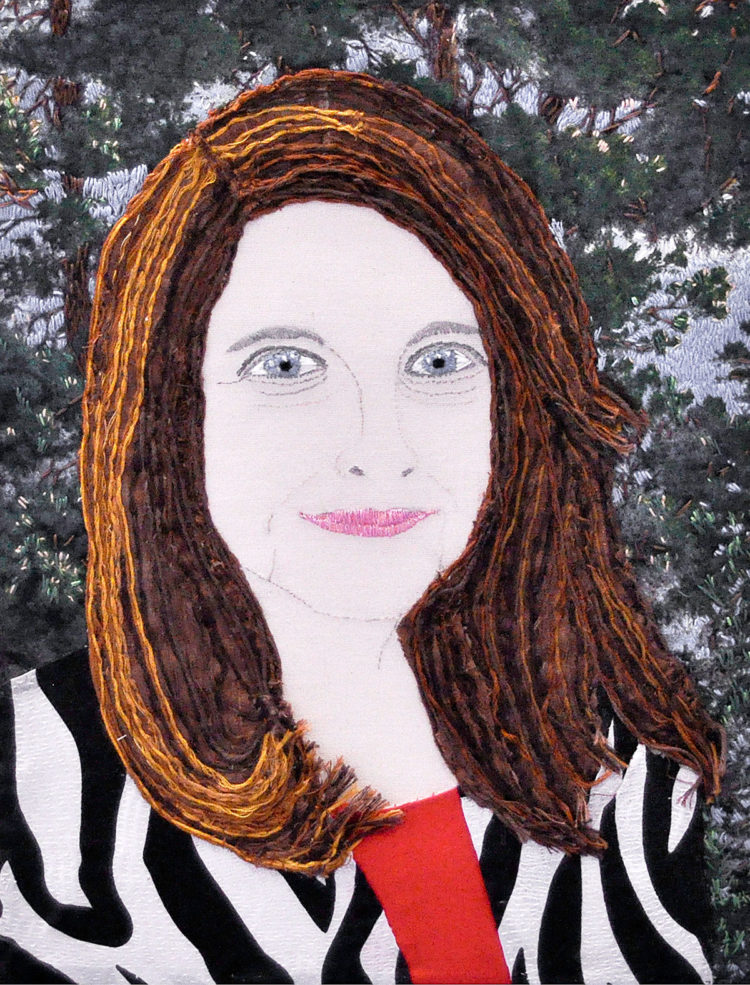
And how has your work developed?
The CTN invited all of the members to submit work for an exhibition called ‘Heads and Tales’.
For the ‘Heads’ exhibition we were asked to do a self-portrait and they invited Sue Stone to come to Cork and run a workshop to help the CTN members develop their self-portraits. Sue was a great help to all of the participants and brought along many samples of her work to guide us. When the self-portraits were completed they were exhibited in the Knitting and Stitching Show 2018 in London, Dublin and Harrogate.
When I finished my self-portrait I initially thought I would follow Sue Stone’s example and work on my own family portraits, but as I worked on my piece for the ‘Tales’ exhibition called ‘The Call of the Wild’ I found that I was more intrigued by making landscape pieces.
Since then I’ve become very interested in perspective and textures in landscape. I am now working on creating landscapes which have depth and textural interest.
Since I started making landscapes last year I feel I have developed my skills in this area and I have particularly enjoyed my recent work in which I tried to convey the 3D nature of rocks by using wadding, water soluble fabric and hand stitching.
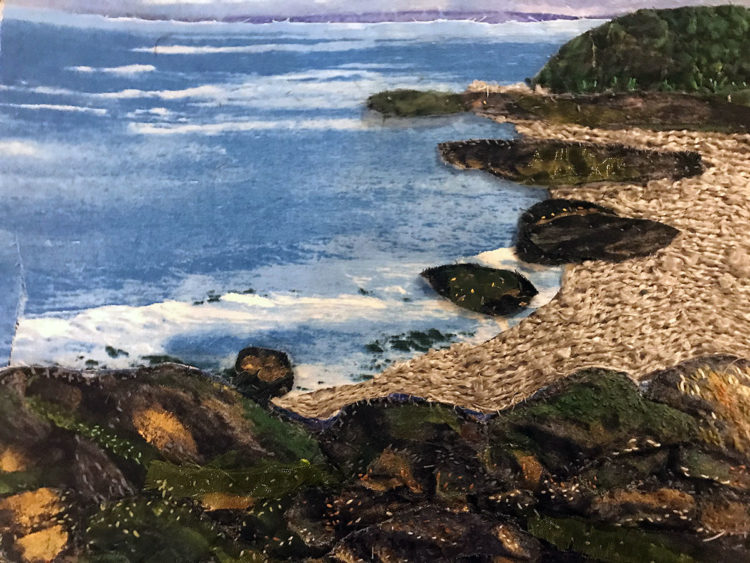
The positive impact of community
What did you most enjoy about Exploring Texture & Pattern and what were the greatest challenges?
Two of the most useful skills I discovered while doing this course were mixing threads in the needle (see the picture below: Mixing threads in the needle and weaving assignment – influenced by Murano glass which I saw in Venice) and couching. I have continued to use these techniques in many of my pieces since taking the course.
The greatest challenge was to keep going. It was sometimes tempting to put off starting the next assignment especially if it seemed initially difficult or unfamiliar. However, the practice of taking up the next challenge and trying it out in the small grids helped keep me motivated.
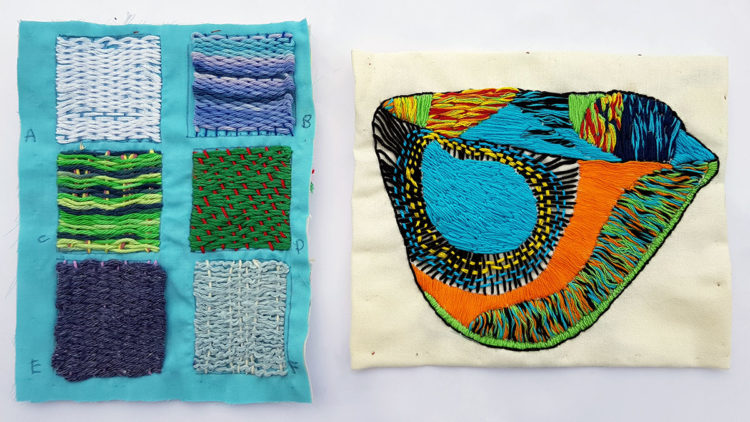
How were you supported on the course and did the interaction with Sue and the other students play an important role in your development?
I suspect that students who study in art colleges can gain very valuable experience from showing, displaying and discussing their work with others. I never had that experience so I kept any work I did more or less hidden from others.
Many people I knew from my teaching, musical or environmental working life did not know that I was interested in textiles at all. So my biggest fear was showing my work to others, worrying that it was and that my textile skills were poor.
However, like a child taking their first wobbly steps in a supportive environment, I found that Sue and the other students helped me tremendously as I posted images of my assignments. Even if my posts were mediocre (and many of them were) the comments and feedback from the other students and Sue helped to give me the confidence to continue and begin to view myself as a textile artist.
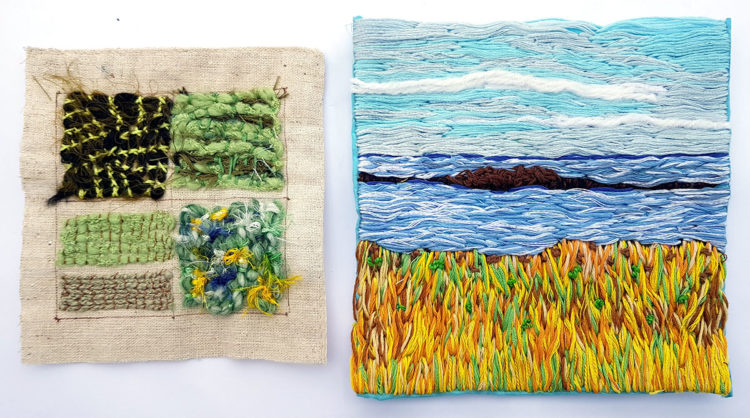
What has been your experience of making textile art since completing the course and which elements of the teaching do you revisit when creating your work if any?
Joining CTN in the group’s twentieth-year celebrations involved exhibitions in the Knitting and Stitching Show and the publication of a book showing the work of the members over the last twenty years.
It has been a great experience for me to be a part of this wonderfully supportive and creative group, who have provided me with an abundance of inspiration and opportunities to submit work to exhibitions.
I don’t live near Cork and so cannot attend their local meetings but I’m very grateful to the CTN for providing me with many creative challenges. I would strongly recommend that other people interested in textiles join a similar type of active textile group and keep developing their skills.
As I have continued to work on stitches, I have added pieces to the stitch sample book (which I made as a final assignment in Exploring Texture & Pattern). I use it as a reference when I’m developing ideas for new pieces.
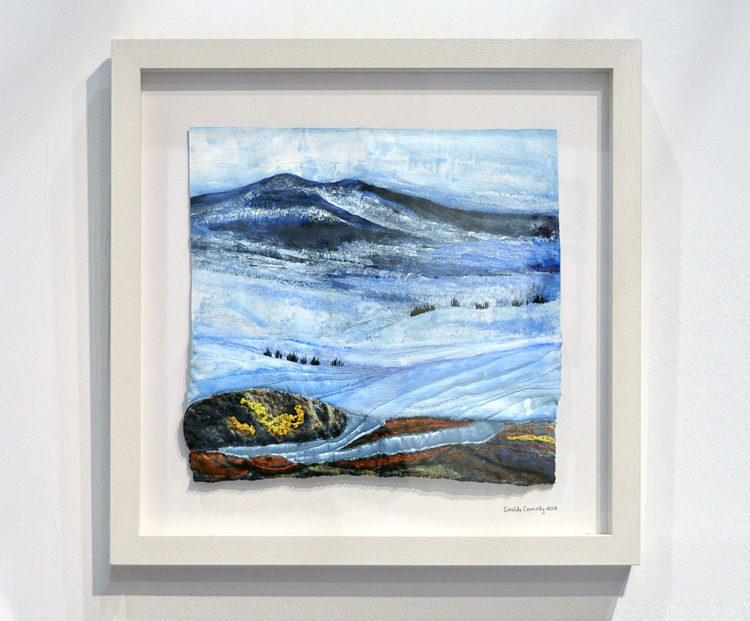
Harsh and hauntingly beautiful landscapes
Tell us about a piece of work you’ve made that you’re particularly proud of and why.
In September 2017 CTN invited members to submit a piece influenced by a book. This piece would be exhibited in the ‘Tales’ exhibition in Cork and following that exhibition, a curated selection of pieces would take place and a selected number of pieces would be exhibited in the CTN ‘Heads and Tales’ exhibition in the Knitting and Stitching Show 2018 in London, Dublin and Harrogate.
My piece is called ‘The Call of the Wild’ and it seemed to be very well received. The curator selected my piece to go into the exhibition tour with the Knitting and Stitching Show and it was subsequently sold at the exhibition.
It is a textured landscape collage measuring 20” x 19”. It was influenced by Jack London’s book ‘The Call of the Wild’ which was based in the Yukon Territory in Northern Canada.
I was also influenced by my own experiences of living in Canada and teaching First Aid to First Nation and other Canadian communities in the outback of North-western Ontario.
This piece conjures up for me the harsh but hauntingly beautiful landscapes of wintertime in Canada.
Can you talk us through the creation of this piece from conception to creation.
When I decided to base my piece on Jack London’s book I spent a long time researching the artwork of the Canadian Group of Seven artists particularly the work of Lawren S. Harris and Tom Thomson and their treatment of winter landscapes.
I was also lucky enough to be able to visit the McMichael Canadian Art Collection in Kleinburg, Ontario while visiting friends in Toronto.
I tried out a number of sketches, chose the one I was happiest with and outlined the sketch with pencil on Vilene (also called Viceleen).
I used fabric paints on the main background, cotton, recycled fabrics and silk for the body of the work, wadding to produce 3D effects on the rocks and water-soluble fabric and a wide range of threads to develop textural interest. I used hand stitching, appliqué and quilting on the rocks.
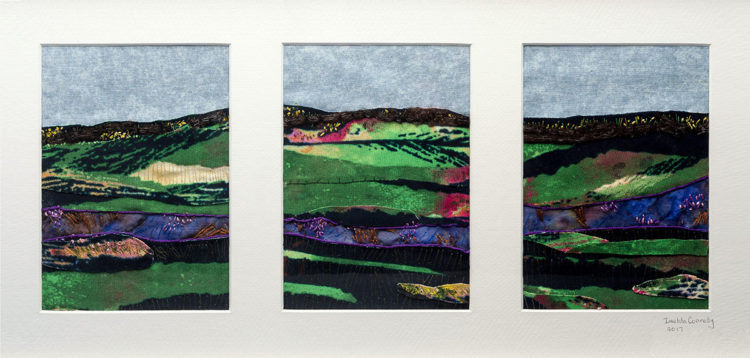
Have you shown any of the work you’ve made and what has the response been?
Since I completed the course I have shown my work in five different exhibitions:
- Knitting and Stitching Show Dublin (November 2017)
- ‘Passing Through’ Exhibition Cork (November 2017)
- ‘Tales’ Exhibition Cork (August 2018)
- ‘Heads and Tales’ touring exhibition with the Knitting and Stitching Show London (October 2018); Dublin (November 2018) and Harrogate (November 2018)
- Da Capo Exhibition Cork (November 2018)
I was lucky enough to win the ‘Long Note Award’ at the ‘Passing Through’ Exhibition in November 2017 and subsequently to have this work included in the book ‘20’ published by CTN in June 2018 to celebrate the twenty years since the group.
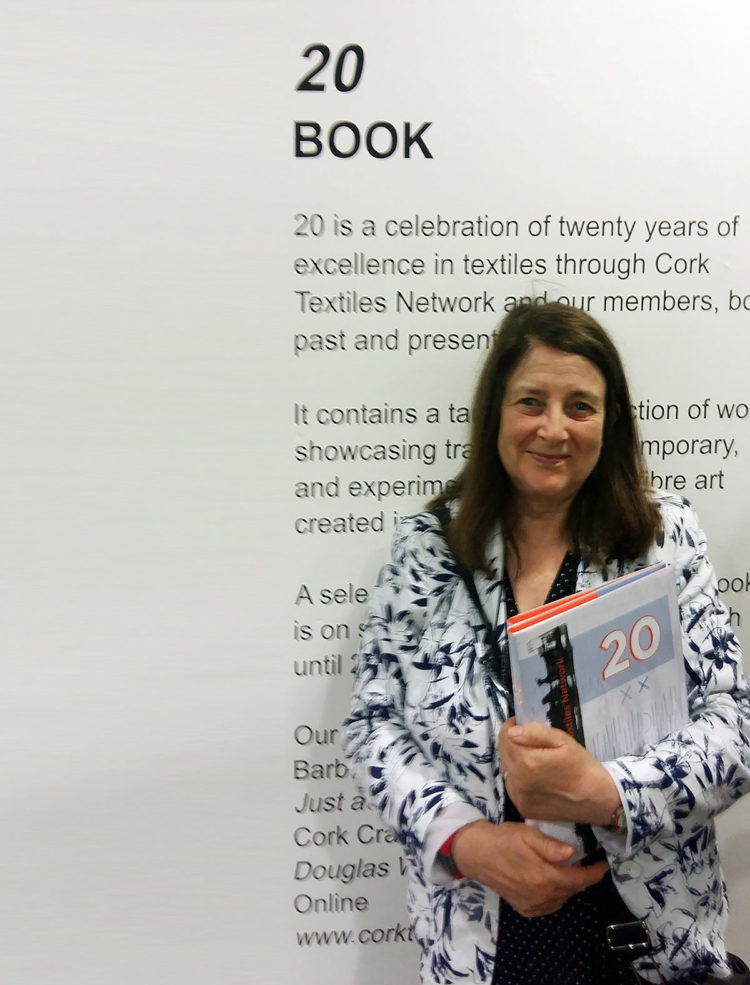
Have you ever harboured a secret love of art but lacked the confidence to share what you create? We’d love to hear your personal story in the comments below.
















Greetings,
Yes! This is me. I am about to explode if I don’t share my art soon. Now I must say I have displayed my fabric art in a coffee shop and in a herbal clinic but never have I mustered up the courage to display professionally. This is probably due to the fact that I do not have a degree in art…although I do in Anthropology and Environmental Studies. That is why I use only recycled textiles and even some plastic objects.
I love your content. It inspires me and makes me feel connected to other artists in this exciting medium.
Kind Regards,
Lisa Marchant
Who says you need a degree in art? You are an artist by your own ability. Congratulations.. and would love to see your work hugs.
Hi Lisa
Many thanks for your lovely comments. I know how you feel having qualifications in an area which is different from art. It can feel as if you are not entitled to consider yourself as an artist! But maybe that stems from specialisation in jobs nowadays but I think people can have a wide variety of interests and skills. You obviously have a strong interest in art and are exhibiting your art so go for it and move on to the next step of exhibiting in a larger venue. Check out local exhibitions and expand your horizon
Best wishes Imelda
Hi this is so inspiring – somehow I got lost part way through sues course – think family and life got in the way ( I was also on the first course) and now I know I must return to it and finish it – so lovely to hear this story thank you
I can relate to your comments here Nicola. I have in the past signed up and paid for different courses thinking I will get stuck in and do them. Unfortunately this is not always the case, I have been dealing with grief and tragic circumstances and even though I read that being or doing creative things will help me, often I find it just too hard to carry anything through. I start but can not seem to finish anything these days? I really need to kick my self in the rear and get going before it is too late! I love Sue’s work and her selfless sharing of her vast knowledge, inspiring as it is I have a huge creativity block. I start and stop so many things thinking maybe this time I will really push on and enjoy something enough to finish it. But alas it is always short lived. I have in my past entered exhibitions, gallery shows in different countries and have my work in places around the world so I do know it is possible. This year I want to move forward…as I grow older I realise focusing on one thing will help. I love too many media and this can stop me from starting anything! I remember Sue saying “just because you can you don’t need to use everything in your knowledge bank”. Thank you for this inspirational interview Imelda and TextileArtist.org, I have made a New Years resolution to come out from the black cloud and start to enjoy creating again.. baby steps.
Hi Nicola see my reply below,
Imelda
I would love to produce work as wonderful as this. Is the course still running?
Hi Sandra – it’s about to start up again. Are you on our mailing list?
Please can I be on mailing list for the textile course?
Thanks
Hi Dawn – I just checked and it looks like you unsubscribed from the mailing list so I’m guessing you no longer need info about the course. If you left the TextileArtist.org community by mistake, just let me know and I’ll send out info about the course. Thanks, Joe
When does it start? I am really interested too
Hi Angharad – I just checked and notice you are on the mailing list so should have received all the info about the course and start dates etc.
Hi,
I would like to get information about Sue’s course next time it is running.
Excited to read what is sent!
How do you sign up to the mailing list please? 🙋Kerin
Hi Kerin – you can sign up by filling out the short form at the bottom of all our articles – you’ll receive the free ebook Making Your Mark as a welcome gift.
Would like to know more about the course please
Hi Diane – are you on our mailing list?
Hi Nicola, Jax and Sandra
I’ve tried to answer your comments individually unsuccessfully so I hope you are okay with a group response?
Thank you Nicola for your lovely comments. I’m sorry that you did not manage to complete the course first time round. Hopefully you will give it another go. You obviously had other issues which were taking up your creative energy at that time and you are now at a different place in your life so give it a go again.
Kaz thank you for your comments and I do hope you are feeling more positive and creative at tis time. Hopefully you are moving on with your new year resolutions and taking those baby steps. As Sue has shown little tasks and challenges can help you to keep creative and thinking textually . I try to keep in mind that life is not a dress rehearsal! Go and do what you want to do now.
Sandra again thanks for your comments and maybe you will join the course too.
Thank you Imelda. I have enrolled on the course which starts next week. I’m so excited and this time I’m determined to see this course through which I’ve not done with other courses I’ve signed up to. Looking forward to 4 February!
It is so good to hear from an artist who has been on Sue’s course and exhibits her work now. Have you also been able to sell any of your work?
I am starting the 2019 course in February and so looking forward to learning how to create textile art successfully and keep creating and finishing.
I loved your work and will look out for any exhibitions when next in Cork. Eve
Hi Eve,
Just seen your message today! I hope you are enjoying the course. To answer your question, I have sold a number of my pieces, won a prize for one piece and have exhibited in about 10 exhibitions. I found that the exercises which I completed during the course helped me to experiment and follow ideas systematically. I’m sure you will gain skills and confidence during the course. Best wishes for your artistic career! Imelda
Hi Imelda.
I was reading your interview. It is so inspiring. I am currently doing Level 1 Award in Textiles and my assignment was to write about the artist who inspires you. You are the one I am writing about. I come from Tajikistan and there are not so many opportunities available for women to demonstrate their creativity like it is in the west and developed countries. My mother grew up in the orphanage and she learned how to stitch there, so she taught me the basics. I would like to gain more knowledge and make her proud by producing something nice as she is watching over me. Thank you very much for sharing your story and proving that one can achieve something in life.
Sabzina
Hi Sabzina,
Thank you so much for your email. I am sure that you are making great progress in your Textiles course. You sound like a creative and enthusiastic student who will strive hard to achieve your goals. Keep up the good work,
Imelda